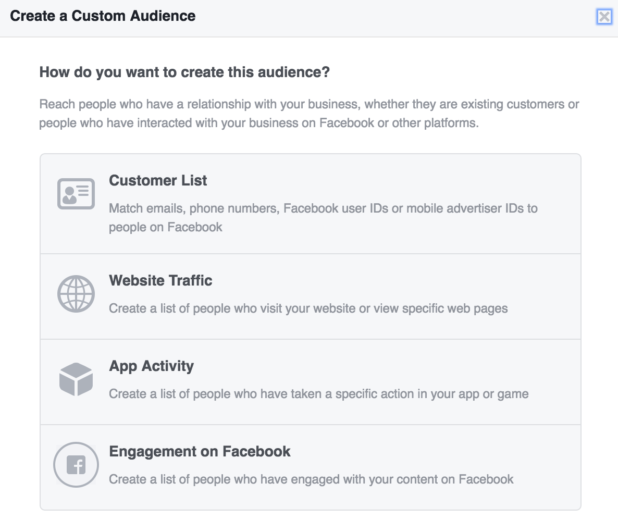For all the praise Facebook gets for being great at generating awareness and introducing your brand to new audiences, it can be equally good at re-engaging existing customers. After all, keeping existing customers is often far less expensive than trying to acquire new ones and your most committed customers can be some of your best supporters.
They’re also more likely to buy from you in the future if they continue to know who you are, what you have to offer, and what makes you stand out.

So what do I mean by re-engaging?
I purposely use the term re-engaging, because I think the strategy of providing content to these people is different than more typical forms of remarketing. These aren’t people doing research, who ended up on a landing page, and who might buy from you. These are people who’ve taken the time to buy a product and invest their hard earned money into you.
You want to keep them interested in what you have to offer. You want them to be focused on your brand story, your community efforts, new products and services, and events. You may not have all of the above, but you likely have content and stories you’d like to tell beyond “Buy More,” and these are a group of people you should be telling
So why use Facebook to re-engage customers when you can just use other channels like email marketing?
Fair question.
I don’t think you shouldn’t use other channels to reach out to these people, but I also don’t think one channel should have a monopoly on certain audiences. Email, as an example, is a more direct one-to-one conversation that takes place in an inbox. It’s less likely to be shared or forwarded from within that inbox, but a message on Facebook has all the options for sharing. Facebook is a social platform after all. Compelling content and stories can be easily commented on, liked, and shared with the click of a button, allowing the message to go further and wider than email is likely to.
So now you have some philosophical reasoning for re-engaging customers and using Facebook.
Now, let’s look at how you can combine components of Facebook’s advertising platform to put this re-engagement into place.
You really just need two pieces:
- The right audiences to target.
- The right ads to generate engagement.
Audiences
The easiest way to target existing customers is by building your audience using Customer Match and email lists.

You can upload any number of email lists sliced and diced the way you see fit and use them to target specific messaging.
You could target people who’ve made a certain amount of purchases, spent a certain dollar amount, engaged in multiple touchpoints with your other marketing, or any number of ways you can dream up of defining customer lists.
The real goal is to create lists of your customers so you can keep them interested in your brand. It’s up to you to determine which metrics define your most committed customers. Once you have your lists built and uploaded to Facebook it’s time to find the best ad formats to fulfill your goals of re-engagement.
Ad Formats
Facebook has many ad formats tailored to different uses and there isn’t any one format that will be the “one” we use for our re-engagement ads.
In theory, we’d want to focus on ads that require more interaction and engagement. These types of ads would include video, carousel, and Canvas that require users to watch and scroll their way through them. Though you might find the static image ads perform well and should be used.
The real key is that you need to decide what your strategy is for keeping these customers engaged and how you want to use Facebook Ads to do it. If you have access to video, then video ads would make sense. If you’re looking for a good mobile experience, Canvas might be the way to go. Just remember, match the message to the ad format. Then match that to the audience and test, test, test.
Conclusion
Facebook is great at generating awareness about your product or service, but that awareness doesn’t just mean introducing “new” people to your brand. It very often can mean reaching out to existing customers to say hello and inform them of new and important things. This kind of outreach might just keep these existing customers invested in what you have to say and what you have to offer.



